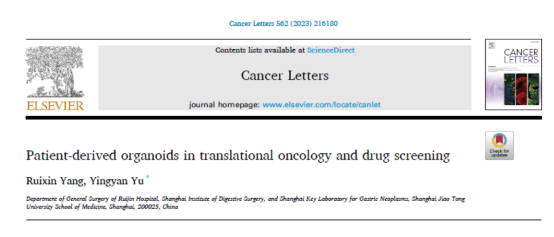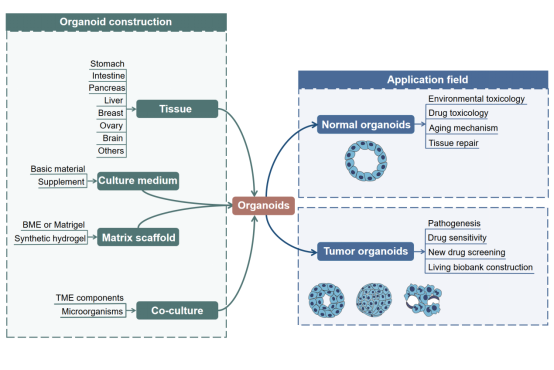Recently, Professor Yingyan Yu's team from Ruijin Hospital affiliated to Shanghai Jiao Tong University School of Medicine published a review article entitled "Patient-derived organoids in translational oncology and drug screening" in Cancer Letters, an authoritative international journal on cancer research. This paper comprehensively describes the latest progress in patient-derived organoid (PDO) from construction to pathogenesis study and drug screening. In the field of biomedicine, organoid models are attracting more and more attention, and it has important reference value. The first author of this article is Ruixin Yang, a doctoral student at Shanghai Jiao Tong University School of Medicine, and the corresponding author is Professor Yingyan Yu.

Abstract:
Patient-derived organoids (PDO) are a new biomedical research model that can reconstruct phenotypic and genetic characteristics of the original tissue and are useful for research on pathogenesis and drug screening. To introduce the progression in this field, we review the key factors of constructing organoids derived from epithelial tissues and cancers, covering culture medium and matrix, morphological characteristics, genetic profiles, high-throughput drug screening, and application potential. We also discuss the co-culture system of cancer organoids with tumor microenvironment (TME) associated cells. The co-culture system is widely used in evaluating crosstalk of cancer cells with TME components, such asfibroblasts, endothelial cells, immune cells,and microorganisms. The article provides a prospective for standardized cultivation mode, automatic morphological evaluation, and drug sensitivity screening using high-throughput methods.
At the end of 2022, the United States passed a newlegislation (FDA Modernization Act 2.0), which attracted global attention. The newlegislation removes the requirement for pharmaceutical companies to use animals to test new drugs before clinical trial, helping to end unnecessary suffering and death of animals. As alternatives, computer modeling andthree-dimensional (3D) tissue culture as well as organoid chips can be employed.
Organoids are 3D cultures of living tissues in an ex vivo environment that is similar to the extracellular niche in vivo. Organoids can well simulate the characteristics ofmorphological structures, functions, and genetic profiles of original organs. Relying on theadult stem cells of living tissues,organoidscan self-renew and differentiate into differentlineages.Since the successful cultivation of intestinal organoids by Sato and colleagues in 2009, organoid technology has developed rapidly.In the past decade,with the progression of experimental technology, successful cultivation of organoids was reported not only in gastrointestinal epithelial tissues, but also in several other tissues such as kidney, ovary, lung, breast, and liver.

Figure 1.The overview of organoid construction and different field of applications. The core elements in organoid construction include tissues collection, culture medium components, matrix biomaterials, as well as development of co-culture system (the left part of the figure). The application of organoids varies depending on whether the origin tissue is normal tissue or tumor tissue (the right side of the figure).
This article is another masterpiece after the team released the Chinese paper entitled "Guideline of construction and preservation of organoids of gastrointestinal epithelial tissues" (T/CMBA 017-2022) authorized by the China Medicinal Biotech Association in 2022. The project was funded by the Shanghai Municipal Science and Technology Commission, the National Natural Science Foundation of China, andthe Collaborative Innovation Center for Clinical and Translational Science by Chinese Ministry of Education & Shanghai.

